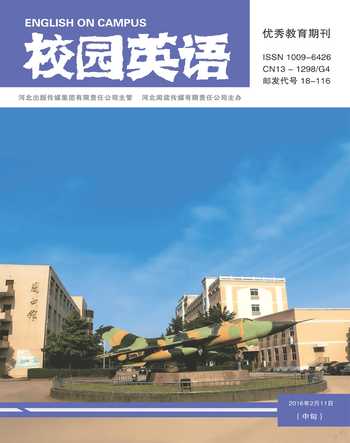Interlingual Transfer in English Learning
王晓娜
【Abstract】Interlingual transfer refers to transfer rules from the first language. There are many differences between English and Chinese, which will unavoidably interfere with the English learning. When the interference of mother tongue fosters target language learning, it is called mother tongues positive transfer. Conversely, the mother tongues negative transfer will emerge. With mother tongue mode of thinking automatically, Chinese students always make errors when they compose a sentence or write a passage. Interlingual transfer includes three aspects: lexical transfer, grammatical transfer and cultural transfer.
【Key words】Interlingual Transfer; English Learning
1. Lexical Transfer
The transfer of vocabulary in the form and meaning may occur if the learners native language and the target language have common origins. As English and Chinese are completely different in writing system, lexical transfer will not occur. However, for the purpose of communication, lexical transfer is frequently used in students writing. The time students fail to find out the correct expression, they resort to their native language and seldom do they pay attention to the rules of the target language. Based on the above analysis, it proves that the lexical transfer of Chinese students in English writing is essentially semantic transfer. Because Chinese students often assume that there exists relationship of semantic equivalents between English and Chinese vocabulary. Namely, Chinese students usually translate literally in writing. This is the main cause resulting in negative transfer of the first language. The following are some typical errors in lexical transfer.
(1) Tom is a well boy. (good)
(2) I cost five dollars on it. (spend)
(3) Please open the light. (turn on)
(4) He is always with pen and book. (always takes)
2. Grammatical Transfer
English and Chinese belong to different language family. There is an obvious extinction between English and Chinese grammar. English has a large number of morphology, but strictly speaking, there is no morphology in Chinese. The grammatical relation is usually indicated by the word order or the isolated auxiliary in Chinese. While in English, the grammatical relation is represented by attaching affixes to the words or simply, the internal changes of the word itself. The moment students encounter difficulties in the syntactic structure of the second language, they use the syntactic structure of their mother tongue. As the two kinds of language are partly equivalent in semantics and structure, students may easily mistake that this equivalent between mother tongue and the second language are absolute. Some typical errors can be found from the following sentences.
(1) Everyone have happy experience. (Disagreement between subject and verb)
(2) When you arrived there, please tell me. (Error in tense)
(3) He did a very perfect job. (Misuse of adjective)
(4) If you in trouble, I will help you.( Error in sentence structure)
3. Cultural Transfer
Language and culture are closely related. There is a big distinction between Chinese and English culture. If the students are in lack of English culture, they will make errors in language acquisition. There is no doubt that Chinese students are impacted greatly by Chinese culture. When students compose a sentence, they will naturally think of Chinese and its culture, and then they translate the sentence literally into English, totally ignoring the different culture between Chinese and English. Errors caused by cultural transfer are countless. Some examples are listed below.
(1) 无风不起浪 No wind, no waves.(No smoke without waves.)
(2) 体壮如牛 as strong as a ox (as strong as a horse)
(3) 小菜一碟 a small dish (be as easy as ABC)
(4) 大海捞针 look for a needle in the ocean (look for a needle in a haystack)
English and Chinese do not belong to the same language department, and they are different in many aspects, such as vocabulary, grammar, culture and so on. If students do not pay attention to these differences and do not avoid the negative transfer from Chinese, they will make errors.
Conclusion
To sum up, the errors of interlingual transfer caused by are various. In the process of English learning, if students pay enough attention to this factor, they can avoid the mother tongues negative transfer. The author prospects that students can distinctly recognize errors caused by interlingual transfer and effectively avoid errors. Besides, teachers can hold a tolerant attitude toward students errors and apply workable strategies to improve students English learning ability.
References:
[1]Gass,S.,and Selinker,L.Language Transfer in Language Learning(Revised Edition)[M].Amsterdam:John Benjamins,1992.
[2]郭铭华.论母语在外语课上的作用[J].外语与外语教学,2002, (04).
[3]束定芳.现代外语教学[M].上海:上海外语教育出版社,1996.
[4]熊锟.再论母语在第二语言习得中的正负迁移作用[J].广西师范大学学报(哲学与社会科学版),2002(1-4).
- 校园英语·中旬的其它文章
- Doubting Altruism: Altruism or Self Interest
- A Design of RFID Antenna based on Left—hand Material
- Two Female Prime Ministers Margaret Thatcher and Julia Gillard
- A Critical Review on Bacon’s Attitudes towards Women
- A simple analysis on the Bretton woods system
- Cigarette use, Cigarette Consumption and Price of Cigarette

